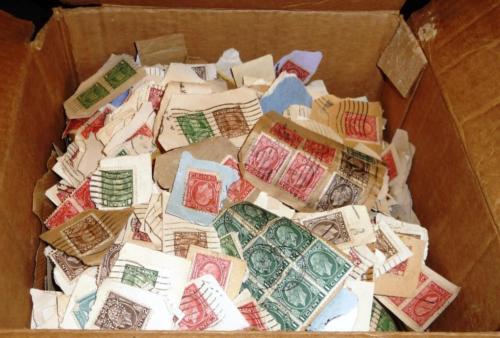Found Stamps
So you are cleaning out a family members house and come across a shoe, cigar, or paper box full of stamps, or maybe an album of stamps. What to do? Well first off, move the stamps to a location that is not in the moist or hot air. I know it is tempting in New England to store lots of stuff in our basement or attics, but surprisingly this is not a great location for things make of paper and glue! After you have gotten it away from the river in the basement, time to take a look at what you got!
Philatelist or collector?
What are you looking at? The first clue is the easiest to assess. The more organized and well laid out the collection is the better indication of the sophistication of the collector. If it is hundreds of glassine envelopes that were kept in a humidity controlled atmosphere and many labels, then you may have a collection that has real worth (you probably did not also just “discover” this collection)! If on the other hand, it is a worn, old, broken box that is filled with the ripped off corners of sent mail from the 1960’s and later…..then I am gonna give you even odds that you are looking at, what I like to call “fire starters.” You or a friend probably has a wood stove, boom; you are all set for next winter!
Well there is a reference guide, isn’t there always? For US stamps, the definitive and most used guide is the Scott Catalogue (yes they spell it with the “e”). It has been around for a long time, how long? Well, the Scott Company has been in the business of servicing stamp collectors and dealers (philatelists) since the 1800’s.
They devised a system for uniquely categorizing every issue from every country around the world. It is quite simple. A number is assigned as each stamp is released. The very first stamp printed from any country is known as Scott #1. In the United States, that was in 1847. Each subsequent issue is chronologically numbered. It’s an open-ended system still being used today with the next number assigned as each new stamp becomes available. So when a philatelist talks about # 12 they are referring to the Scott Catalogue # 12. Which BTW is an 1856 5¢.
Check out
Are they worth a lot?
Another fact you should be aware of, the values in the Scott Catalogue are NOT to be used as a reference for real money today. In most cases, except the rare and unique stamps, the market heyday was in the 1970-80s. At auction today, we are getting 5-15% of catalog value at auction. It is a shame, but a factor of the collapsing market that stamps are, and the reality of the diminishing use of stamps worldwide.
A stamp that is just a non-collectable everyday stamp is what we like to call postage, and its best and highest value is just that, as postage. If you have the time or want to save a buck or two, lick and stick your way to holiday cards, church mailings, or community mailers, as you will not get more than face value for your stamps.
Either way, call us to talk to us, or shoot us an email with photos, and we will be happy to give you more information to help in your decision-making process.





